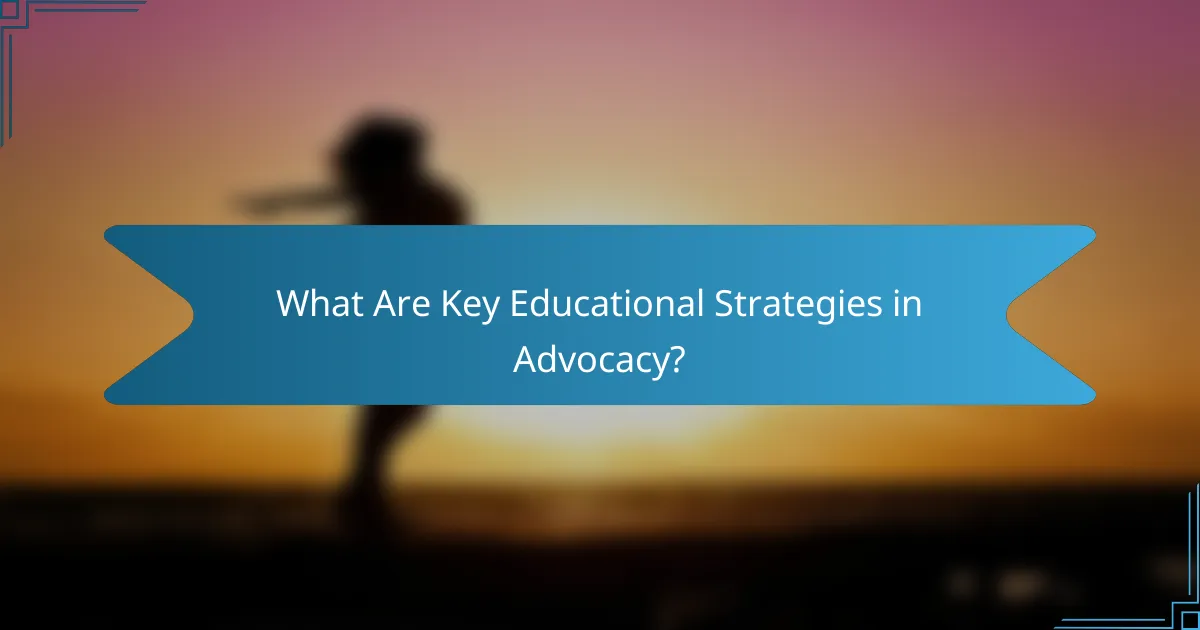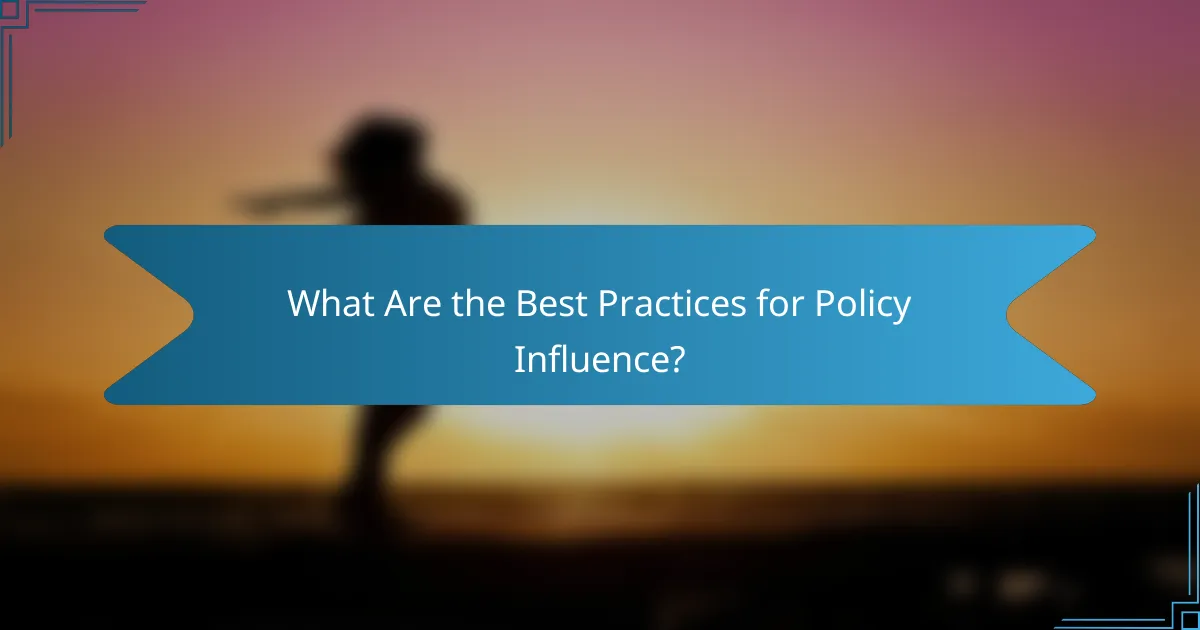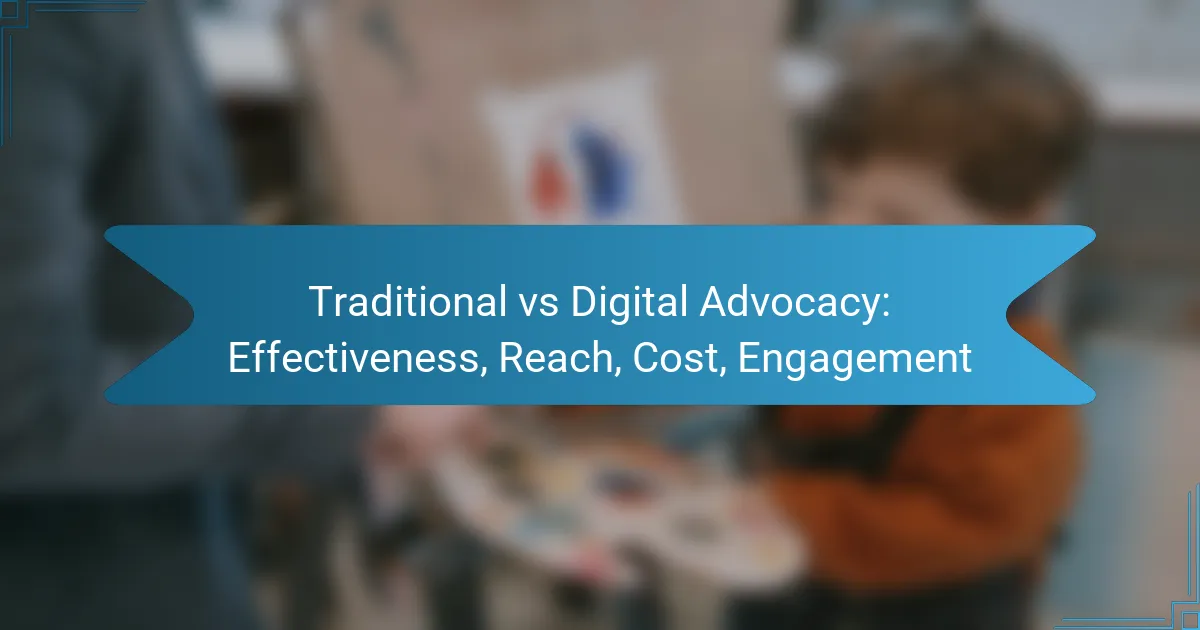Advocacy techniques play a crucial role in driving social change by engaging, mobilizing, educating, and building coalitions among individuals and communities. By actively involving supporters and fostering awareness, these methods create a strong foundation for influencing policy and promoting specific causes. Effective advocacy not only empowers individuals with knowledge and skills but also encourages collective action to address pressing issues.

What Are Effective Advocacy Techniques for Engagement?
Effective advocacy techniques for engagement focus on actively involving individuals and communities in the advocacy process. These methods foster participation, raise awareness, and build support for specific causes or policies.
Community outreach programs
Community outreach programs aim to connect with local populations to inform them about issues and mobilize support. These programs can include door-to-door canvassing, informational booths at community events, or partnerships with local organizations.
When planning outreach, consider the demographics and interests of your target audience. Tailoring your message and approach can significantly enhance engagement and participation.
Social media campaigns
Social media campaigns leverage platforms like Facebook, Twitter, and Instagram to spread awareness and encourage action. These campaigns can include targeted ads, hashtag movements, and interactive content to engage users.
To maximize impact, create visually appealing posts and use analytics to track engagement. Regularly updating content and responding to followers can help maintain momentum and foster community around your cause.
Public speaking events
Public speaking events provide opportunities to share your advocacy message directly with an audience. These can range from formal presentations at conferences to informal talks at community centers.
Effective public speaking involves clear messaging, engaging storytelling, and addressing audience questions. Practicing your delivery and using visual aids can enhance the overall impact of your presentation.
Workshops and training sessions
Workshops and training sessions educate participants on specific advocacy skills or issues. These interactive sessions can cover topics like lobbying techniques, grassroots organizing, or effective communication strategies.
Consider offering both in-person and virtual options to reach a wider audience. Providing materials and resources for participants to take home can reinforce learning and encourage ongoing engagement.
Storytelling initiatives
Storytelling initiatives harness the power of personal narratives to connect emotionally with audiences. Sharing real-life experiences related to your advocacy can humanize issues and inspire action.
Encourage community members to share their stories through various mediums, such as videos, blogs, or live events. Highlighting diverse perspectives can enrich your advocacy efforts and broaden your reach.

How to Mobilize Supporters in Advocacy?
Mobilizing supporters in advocacy involves engaging individuals to take action on a cause, often through organized efforts. Effective mobilization combines strategic outreach, community involvement, and clear communication to inspire participation and drive change.
Grassroots organizing
Grassroots organizing focuses on building a strong base of local supporters who are passionate about a cause. This approach often includes door-to-door canvassing, community meetings, and leveraging social media to spread awareness and gather support.
To be effective, grassroots efforts should prioritize relationship-building and empower community members to take ownership of the advocacy initiative. Consider training volunteers on key messaging and providing them with resources to share within their networks.
Petition drives
Petition drives are a powerful way to demonstrate public support for an issue. By collecting signatures, advocates can show decision-makers the level of community backing for their cause, which can influence policy changes or actions.
When organizing a petition drive, set clear goals for the number of signatures needed and establish a timeline. Utilize both online platforms and physical locations to reach a broader audience, and ensure that the petition clearly outlines the desired outcome.
Volunteer recruitment strategies
Recruiting volunteers is essential for successful advocacy efforts. Effective strategies include leveraging social media campaigns, hosting informational sessions, and collaborating with local organizations to tap into existing networks.
To retain volunteers, provide them with meaningful roles and recognize their contributions. Regular communication and updates about the advocacy progress can help maintain enthusiasm and commitment among volunteers.
Engagement through local events
Local events are an excellent way to engage supporters and raise awareness about advocacy issues. Organizing community gatherings, workshops, or informational booths can foster connections and encourage participation.
Consider partnering with local businesses or community centers to host events that are accessible and appealing to a wide audience. Use these opportunities to share stories, provide educational materials, and invite attendees to take action, such as signing petitions or joining volunteer efforts.

What Are Key Educational Strategies in Advocacy?
Key educational strategies in advocacy include methods that inform and empower individuals to engage effectively in policy discussions and community initiatives. These strategies enhance understanding, build skills, and foster collaboration among advocates.
Workshops and seminars
Workshops and seminars provide hands-on learning experiences that allow participants to engage directly with advocacy topics. These sessions often include interactive elements, such as role-playing or group discussions, which can enhance understanding and retention of information.
When organizing workshops, consider the target audience’s prior knowledge and tailor the content accordingly. Aim for sessions that last between two to four hours to maintain engagement without overwhelming participants.
Informational resources and toolkits
Informational resources and toolkits serve as valuable references for advocates seeking guidance on specific issues or strategies. These materials can include guides, fact sheets, and templates that simplify complex topics and provide step-by-step instructions.
Creating a toolkit that addresses local regulations and advocacy practices can significantly increase its effectiveness. Ensure that resources are accessible both online and in print to reach a broader audience.
Online courses and webinars
Online courses and webinars offer flexible learning opportunities for advocates who may not be able to attend in-person events. These formats can cover a wide range of topics, from basic advocacy skills to advanced policy analysis, often featuring expert speakers.
To maximize participation, keep online sessions between 30 to 90 minutes and include interactive components like Q&A sessions. Providing recorded versions can also help reach those who cannot attend live sessions.

How to Build Effective Coalitions?
Building effective coalitions involves uniting diverse groups around shared objectives to amplify advocacy efforts. This process requires clear communication, collaborative planning, and a commitment to common goals.
Identifying common goals
Identifying common goals is crucial for coalition success. Start by engaging all potential members in discussions to uncover overlapping interests and objectives. This alignment fosters a sense of unity and purpose.
Consider using surveys or focus groups to gather input from stakeholders. Aim for goals that are specific, measurable, achievable, relevant, and time-bound (SMART) to ensure clarity and focus.
Establishing clear communication channels
Clear communication channels are essential for maintaining cohesion within a coalition. Establish regular meetings, utilize collaborative tools, and create a shared platform for information exchange to keep all members informed and engaged.
Utilize tools like Slack or Microsoft Teams for real-time communication and Google Drive for document sharing. Ensure that all members are comfortable with the chosen platforms to avoid miscommunication.
Collaborative planning sessions
Collaborative planning sessions allow coalition members to strategize and develop action plans together. Schedule these sessions regularly to review progress, adjust strategies, and reinforce commitment to shared goals.
During these sessions, encourage open dialogue and brainstorming to foster creativity. Use techniques like SWOT analysis (Strengths, Weaknesses, Opportunities, Threats) to evaluate the coalition’s position and refine plans effectively.

What Are the Best Practices for Policy Influence?
Effective policy influence involves strategic approaches that engage stakeholders, communicate research, and build relationships with decision-makers. Best practices include understanding the political landscape, utilizing data-driven arguments, and fostering collaboration among diverse groups.
Lobbying techniques
Lobbying techniques are essential for directly influencing policymakers. These can include one-on-one meetings, providing testimony at hearings, and organizing grassroots campaigns. It’s crucial to understand the specific rules and regulations governing lobbying in your region, as they can vary significantly.
Effective lobbying often involves creating a clear message and identifying key decision-makers. Building relationships with legislators and their staff can enhance credibility and increase the chances of successful advocacy. Regular follow-ups and updates on issues can keep the conversation alive.
Engaging with policymakers
Engaging with policymakers requires a proactive approach. This can be achieved through formal channels like public consultations or informal gatherings such as community events. Tailoring your message to align with the interests and priorities of policymakers can make your advocacy efforts more impactful.
Consider scheduling briefings to present your case clearly and concisely. Providing policymakers with actionable recommendations can facilitate their decision-making process. Remember to follow up after meetings to reinforce your points and maintain the relationship.
Research and data presentation
Research and data presentation are critical in substantiating your policy arguments. Use reliable sources and present data in a clear, accessible format, such as charts or infographics. This can help convey complex information more effectively and make your case more persuasive.
When presenting data, focus on key findings that directly support your policy goals. Avoid overwhelming policymakers with excessive information; instead, highlight the most relevant statistics. Providing context for the data can also enhance understanding and demonstrate its significance in real-world scenarios.



